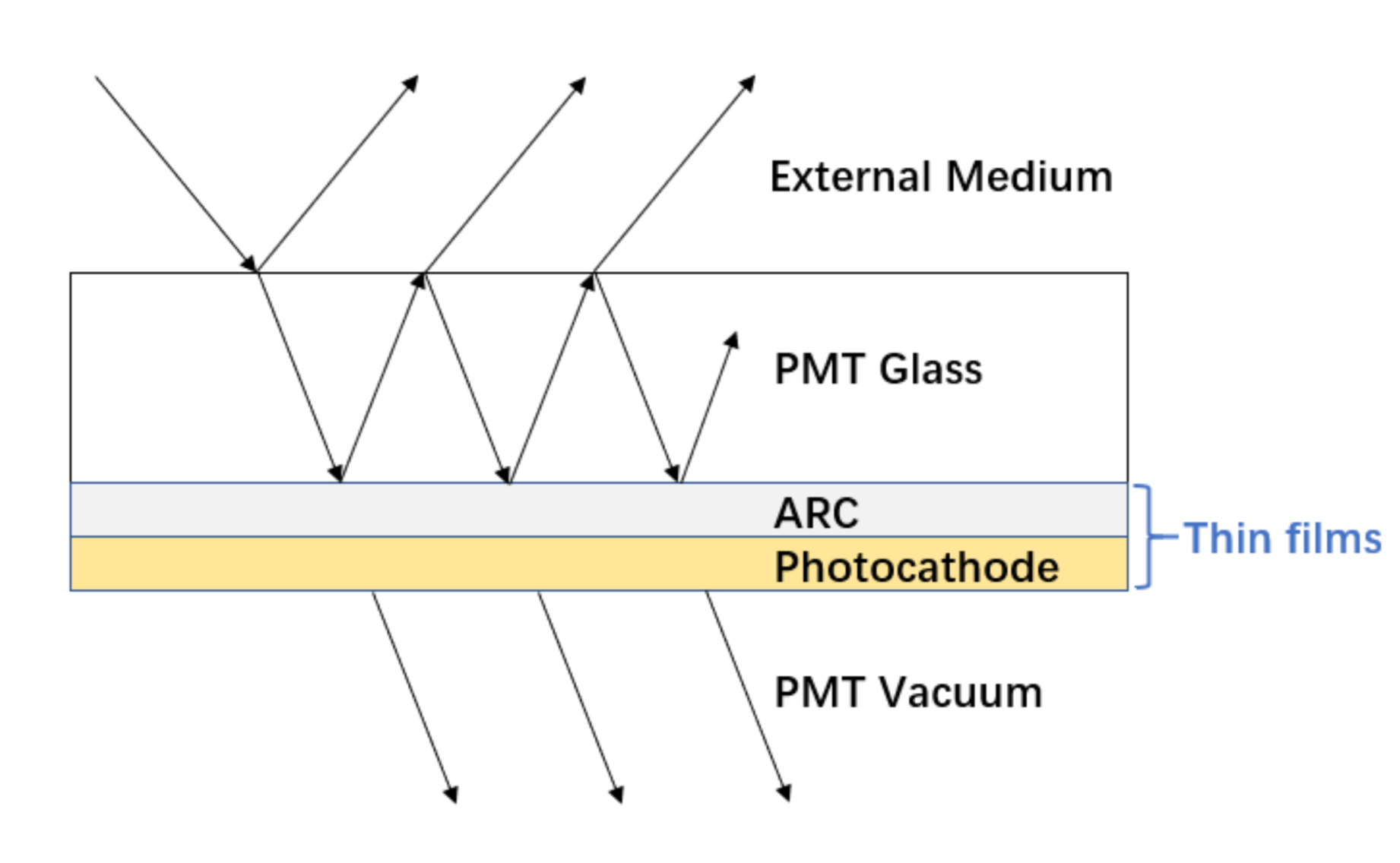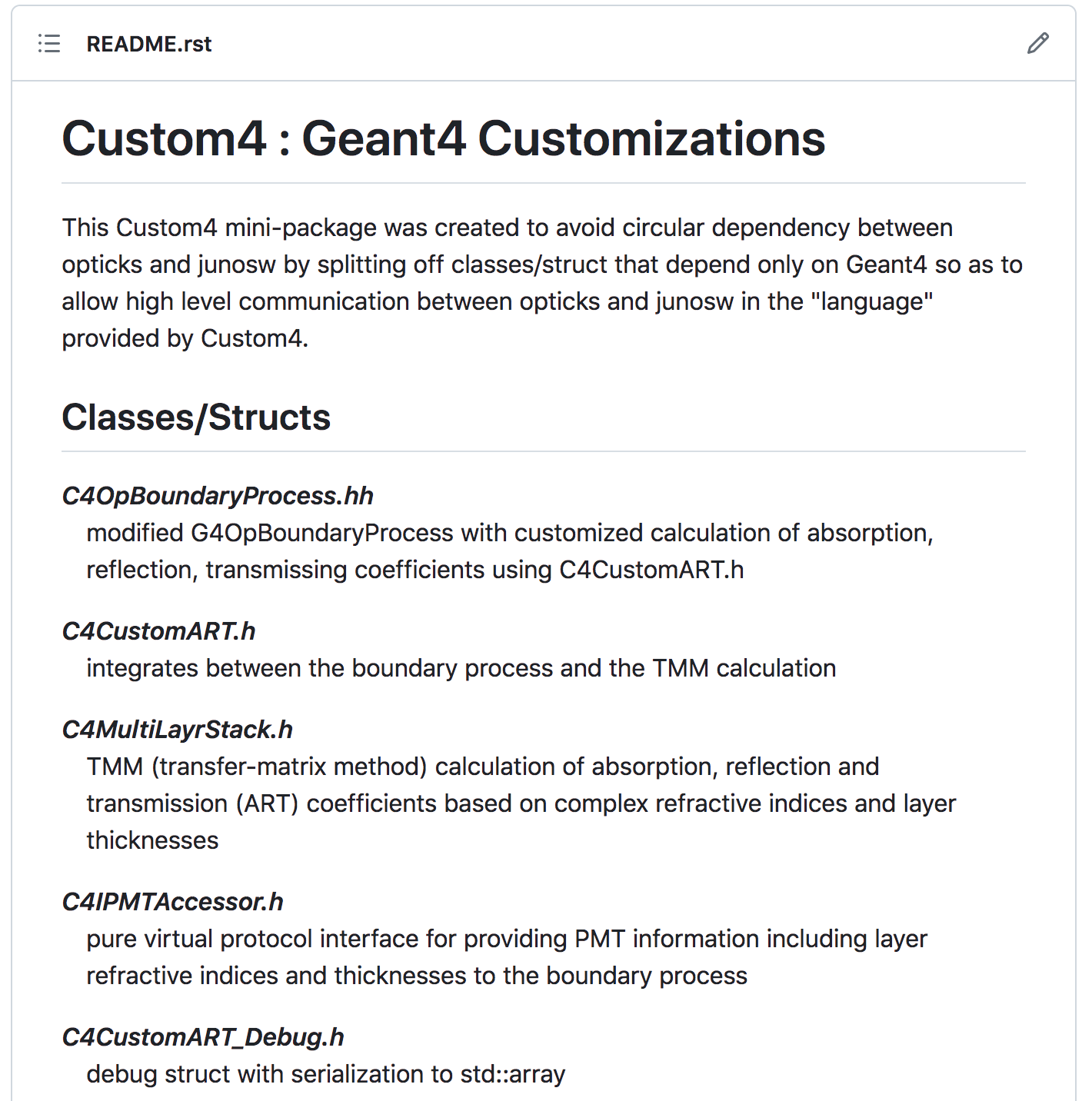G4OpBoundaryProcess : thin photocathode + anti-reflective coating transfer-matrix method A,R,T,D calculation
G4OpBoundaryProcess with thin photocathode/anti-reflective coating transfer-matrix method A,R,T,E calculation
- Custom4 : Custom Boundary Multi-Layer Thin Film (A,R,T) TMM Calc
- Natural 2 volume PMT geometry : HAMA and NNVT
- G4OpBoundaryProcess : customized for JUNO PMT Optical Model (POM)
- C4OpBoundaryProcess::PostStepDoIt : 3-way (A,R,T) Customization
- custom4/C4CustomART.h : include into C4OpBoundaryProcess.cc
- Low dependency access to PMT data from anywhere
- CUDA equivalent of C4CustomART::doIt : With Full LPMT info
- A,R,T AOI scans
Simon C Blyth, IHEP, CAS — Geant4 Technical Forum : Boundary Process Customization — 15 Feb 2024
Custom4 : Custom Boundary Multi-Layer Thin Film (A,R,T)+E TMM Calc
TMM : Transfer Matrix Method

multi-layer thin films, coherent calc:
- complex refractives indices, thicknesses
- => (A,R,T) (Absorb, Reflect, Transmit) + E (Efficiency)
- Used from C4OpBoundaryProcess
header-only GPU/CPU : C4MultiLayrStack.h
- Custom4 depends only on Geant4
- Dependency of JUNOSW and Opticks

https://github.com/simoncblyth/customgeant4/
FewPMT_demo.png
Natural 2 volume PMT geometry : HAMA and NNVT
G4OpBoundaryProcess : customized for JUNO PMT Optical Model (POM)
Custom Boundary POM
+---------------pmt-Pyrex----------------+ | | | | | | | +~inner~Vacuum~~~~~~~~~~~+ | | ! ! | | ! ! | | ! ! | | ! ! | | ! ! | | + + | | | | | | | | | | | | | | | | | | | | | | +------------------------+ | | | | | | | +----------------------------------------+
OpSurfaceName[0] == '@'
- local_z>0 : does MultiLayer ART calc
- !(local_z>0) : standard mirror_opsurf
Custom Boundary Process : Advantages
- natural geometry, no fakes
- standard Geant4 polarization, propagation, time
- less code, simpler code
- simpler Geant4 step history (no fakes)
- same geometry on GPU+CPU, easier Opticks validation
- half the geometry objects to model PMT (4->2)
| Old FastSim POM | 4 Solid, 4 LV, 4 PV |
| Custom Boundary POM | 2 Solid, 2 LV, 2 PV |
Disadvantages
- maintain Custom4 C4OpBoundaryProcess
- updating Geant4 needs care if G4OpBoundaryProcess changed
- Advantages far outweigh disadvantages
- JUNOSW MERGED May 25, 2023
https://github.com/simoncblyth/customgeant4/
C4OpBoundaryProcess::PostStepDoIt : 3-way (A,R,T) Customization
PostStepDoIt type switch
if( m_custom_status == 'Y' ) // CustomART handling { G4double rand = G4UniformRand(); if ( rand < theAbsorption ) { DoAbsorption(); // A } else { DielectricDielectric(); // R or T } } else if (type == dielectric_metal) { DielectricMetal(); } ...
Standard DoAbsorption DielectricDielectric reused
G4OpBoundaryProcess unless OpticalSurfaceNam[0] == '@'/'#'
if( OpticalSurfaceName0 == '@' || OpticalSurfaceName0 == '#' )
{
if( m_custom_art->local_z(aTrack) < 0. ) // Lower hemi : Standard
{
m_custom_status = 'Z' ;
}
else if( OpticalSurfaceName0 == '@') // MultiFilm ART POM
{
m_custom_status = 'Y' ;
m_custom_art->doIt(aTrack, aStep) ;
type = dielectric_dielectric ;
theModel = glisur ;
theFinish = polished ;
}
else if( OpticalSurfaceName0 == '#' ) // Traditional POM
{
m_custom_status = '-' ;
type = dielectric_metal ;
theModel = glisur ;
theReflectivity = 0. ;
theTransmittance = 0. ;
theEfficiency = 1. ;
}
}
DielectricDielectric expects 2-way (theReflectivity,theTransmittance) => so C4CustomART.h rescales 3-way (A,R,T)
(theAbsorption,theReflectivity,theTransmittance) <= (A, R/(1-A), T/(1-A))
custom4/C4CustomART.h : include into C4OpBoundaryProcess.cc
C4CustomART customizations
doIt C4MultiLayrStack.h TMM calc, only for:
- OpticalSurfaceName[0]=='@' && local_z > 0
- -> Absorption, Transmittance, Reflectivity, Efficiency
- changed via references collected by ctor
reuse standard G4OpBoundaryProcess
- standard reflect, refract, absorb, detect
- standard polarization
- standard time, speed
- "inject" minimal change needed for POM
#include "C4IPMTAccessor.h"
#include "C4MultiLayrStack.h"
#include "C4Touchable.h"
struct C4CustomART {
const C4IPMTAccessor* accessor ;
G4double& theAbsorption ; // doIt sets these
G4double& theReflectivity ;
G4double& theTransmittance ;
G4double& theEfficiency ;
const G4ThreeVector& theGlobalPoint ;
const G4ThreeVector& OldMomentum ;
const G4ThreeVector& OldPolarization ;
const G4ThreeVector& theRecoveredNormal ;
const G4double& thePhotonMomentum ;
C4CustomART(
const C4IPMTAccessor* accessor,
G4double& theAbsorption,
G4double& theReflectivity,
G4double& theTransmittance,
G4double& theEfficiency,
const G4ThreeVector& theGlobalPoint,
const G4ThreeVector& OldMomentum,
const G4ThreeVector& OldPolarization,
const G4ThreeVector& theRecoveredNormal,
const G4double& thePhotonMomentum
);
double local_z( const G4Track& aTrack );
void doIt(const G4Track& aTrack, const G4Step& aStep );
};
https://github.com/simoncblyth/customgeant4/blob/main/C4CustomART.h
Low dependency access to PMT data from anywhere
Why Low Dependency Access ?
- REQUIRED, BY Custom4 + Opticks
- CODING BEST PRACTICE
- less deps -> more useful code
- test separate from the "monolith"
- development cycle < 1 s (vs minutes)
- serialization with NP.hh,NPFold.h
QE scan over 100 energy points, all PMTs
| IPMTSimParamSvc | 7.70 s |
| PMTSimParamData | 0.30 s |
| IPMTSimParamSvc/PMTSimParamData | 26.10 |
- exactly same results, 26x faster
| MR 126 MERGED Feb 3, 2023 |
Full PMT access from Custom4 + Opticks without Svc : How ?
- Add PMTSimParamData "core" to PMTSimParamSvc
- consistent by design from any source file/DB/Frontier/...
- Add PMTAccessor impl. of protocol base C4IPMTAccessor
- header only impl + serialization => PMT data anywhere
- => liberate PMT data from monolith
SimSvc/PMTSimParamSvc/PMTSimParamSvc/PMTAccessor.h
#include "C4IPMTAccessor.h"
struct PMTAccessor : public C4IPMTAccessor
{
PMTAccessor(const PMTSimParamData* data);
int get_num_lpmt() const ;
double get_pmtid_qe( int pmtid, double energy ) const ;
...Pure virtual protocol base : Custom4/C4IPMTAccessor.h
struct C4IPMTAccessor // only standard types in API
{
virtual int get_num_lpmt() const = 0 ;
virtual double get_pmtid_qe( int pmtid, double energy ) const = 0 ;
virtual double get_qescale( int pmtid ) const = 0 ;
...
Consistent PMT data access : JUNOSW + Opticks + Custom4
CUDA equivalent of C4CustomART::doIt : With Full LPMT info
qsim::propagate_at_surface_CustomART
int qsim::propagate_at_surface_CustomART(
unsigned& flag, curandStateXORWOW& rng, sctx& ctx) const
{
const sphoton& p = ctx.p ;
const float3* nrm = (float3*)&ctx.prd->q0.f.x ;
int lpmtid = ctx.prd->identity(); //0->17611
float minus_cos_theta = dot(p.mom, *nrm);
float dot_pol_x_mom_nrm = dot(p.pol,cross(p.mom,*nrm));
// enables calc of S/P-polarization fraction
float ARTE[4] ;
pmt->get_lpmtid_ARTE(ARTE, lpmtid, p.wavelength,
minus_cos_theta, dot_pol_x_mom_nrm );
const float& A = ARTE[0]; // Absorb
const float& T = ARTE[2]; // Transmit (R+T=1)
const float& E = ARTE[3]; // Effic: _qe/A_norm
float u_A = curand_uniform(&rng);
int action = u_A < A ? BREAK : CONTINUE ;
if( action == BREAK ){
float u_E = curand_uniform(&rng) ;
flag = u_E < E ? SURFACE_DETECT : SURFACE_ABSORB ;
} else {
propagate_at_boundary( flag, rng, ctx, T );
}
return action ;
}
- JSW:PMTSimParamSvc
- fills PMTSimParamData from file/DB/frontier/...
- JSW:PMTSimParamData (added in MR 126)
- data "core" of PMTSimParamSvc
- JSW:_PMTSimParamData (added in MR 126)
- serialize PMTSimParamData into Opticks NPFold.h/NP.hh
- sysrap/SPMT.h
- _PMTSimParamData NPFold => summary arrays
- qudarap/QPMT.hh
- upload PMT summary arrays to GPU
- QProp.hh/qprop.h interpolation setup (RINDEX,KINDEX)
- instanciates qpmt.h instance and uploads
- qudarap/qpmt.h
- provides PMT info, TMM calc to qsim.h
- includes Custom4 : C4MultiLayrStack.h
- qpmt::get_lpmtid_ARTE
https://bitbucket.org/simoncblyth/opticks/src/master/qudarap/qpmt.h
LayrTest__R12860_QPMT_Test.png
LayrTest__R12860_Aspa.png
LayrTest__R12860_Rspa.png
LayrTest__R12860_Tspa.png
Comparing AOI scans : j/Layr/LayrTest.sh
Shapes
In [6]: h.f.art.shape Out[6]: (9, 900, 4, 4) In [7]: h.f.comp.shape Out[7]: (9, 900, 1, 4, 4, 2)
CFLayrTest a : LayrTest : scan__R12860__cpu_thr_double b : LayrTest : scan__R12860__cpu_thr_float c : LayrTest : scan__R12860__gpu_thr_double d : LayrTest : scan__R12860__gpu_thr_float e : SPMT_test : sscan f : QPMTTest : qscan g : QPMT_MockTest : qscan h : QPMT_Test : qscan ## tab, rst = ts.cf_table(tt, pmtcat, excl=excl) # excl 0.05 ## rst +------------------------------+----------+----------+----------+----------+----------+----------+----------+----------+ | R12860 art\comp 0.05| a:ctd| b:ctf| c:gtd| d:gtf| e:| f:| g:| h:| +==============================+==========+==========+==========+==========+==========+==========+==========+==========+ | a:ctd| 0| 4.829e-05| 1.066e-14| 4.829e-05| 8.644e-05| 3.422e-05| 4.255e-05| 3.685e-05| +------------------------------+----------+----------+----------+----------+----------+----------+----------+----------+ | b:ctf| 9.317e-07| 0| 4.829e-05| 5.722e-06| 4.578e-05| 5.15e-05| 5.15e-05| 5.531e-05| +------------------------------+----------+----------+----------+----------+----------+----------+----------+----------+ | c:gtd| 1.582e-15| 9.317e-07| 0| 4.829e-05| 8.644e-05| 3.422e-05| 4.255e-05| 3.685e-05| +------------------------------+----------+----------+----------+----------+----------+----------+----------+----------+ | d:gtf| 7.958e-07| 8.792e-07| 7.958e-07| 0| 4.196e-05| 5.341e-05| 5.722e-05| 5.913e-05| +------------------------------+----------+----------+----------+----------+----------+----------+----------+----------+ | e:| 2.956e-06| 3.159e-06| 2.956e-06| 3.07e-06| 0| 5.341e-05| 5.15e-05| 4.959e-05| +------------------------------+----------+----------+----------+----------+----------+----------+----------+----------+ | f:| 3.094e-06| 3.338e-06| 3.094e-06| 3.159e-06| 1.192e-06| 0| 1.335e-05| 9.537e-06| +------------------------------+----------+----------+----------+----------+----------+----------+----------+----------+ | g:| 2.956e-06| 3.159e-06| 2.956e-06| 3.07e-06| 7.451e-07| 1.103e-06| 0| 7.629e-06| +------------------------------+----------+----------+----------+----------+----------+----------+----------+----------+ | h:| 2.907e-06| 3.248e-06| 2.907e-06| 2.921e-06| 7.451e-07| 8.941e-07| 8.419e-07| 0| +------------------------------+----------+----------+----------+----------+----------+----------+----------+----------+
Largest differences between ART (9, 900, 4, 4) from various tests (float,double,GPU,CPU,mock-CPU,standalone...)